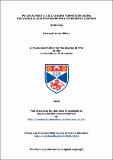Files in this item
Pd catalysed C-C & C-O bond formation using bis-(dialkyl/diarylphosphino)ferrocene ligands
Item metadata
| dc.contributor.advisor | Clarke, Matt | |
| dc.contributor.author | Milton, Edward J. | |
| dc.coverage.spatial | 146 | en_US |
| dc.date.accessioned | 2010-09-22T15:33:59Z | |
| dc.date.available | 2010-09-22T15:33:59Z | |
| dc.date.issued | 2010-06-23 | |
| dc.identifier | uk.bl.ethos.552431 | |
| dc.identifier.uri | https://hdl.handle.net/10023/1022 | |
| dc.description.abstract | A brief introduction explaining phosphine ligand properties, Pd catalysed cross-coupling reactions; the importance of the steps involved in the catalytic cycle (oxidative addition, transmetalation & reductive elimination), mechanistic studies and a comparison of various reactions will give an overview of important cross-coupling reactions and their limitations.The development of a “super-concentrated” (5M) Pd catalysed Kumada type coupling reaction has been developed for coupling a range of aryl bromide and chloride substrates with the Grignard reagents ((p-CF₃-C₆H₄)MgBr)) and PhMgBr in methyl-tetrahydrofuran (Me-THF). Using a range of bidentate ligands such as bis-phosphinoferrocenyl ligands, good conversions were achieved using small amounts of solvent; up to 10 times less than typical procedures in THF. The unsymmetrical Pt complexes of the form [Pt(P-P)Br₂], [Pt(P-P)(Ph)Br] and [Pt(P-P)Ph₂] have been synthesised and characterised. The variations of substituents on the ligand system and the steric bulk have been shown to have a dramatic effect on the rate of transmetalation. The results provide one explanation why 1,1’-bis(di tert-butylphosphino)ferrocene (dtbpf), an excellent ligand for certain Suzuki reactions, is quite poor in reactions where transmetalation is more difficult. Palladium dichloride complexes of the ferrocenylphosphine based ligands 1,1’-bis- (diphenylphosphino)ferrocene (dppf), 1,1’-bis-(diisopropylphosphino)ferrocene (dippf) and 1,1’-bis-(di-tert-butylphosphino)ferrocene (dtbpf) have been shown to be active in the Hiyama cross-coupling of p-bromoacetophenone and vinyltrimethoxysilane (CHCH₂Si(OMe₃)) in the presence of TBAF under thermal heating and microwave conditions. Ligands with the optimum balance for promoting the transmetalation, oxidative addition and reductive elimination steps along the reaction pathway have been identified. Competition experiments are consistent with slow transmetalation being an issue with the Hiyama reaction relative to the Suzuki coupling.A novel protocol has been developed for the synthesis of aryl-alkyl ethers via C-O bond activation under Pd catalysed conditions. Utilising the unsymmetrical 1-bis-(ditertbutyl-1’- bis-diphenylphosphino)ferrocene (dtbdppf) under optimised conditions with silicon based nucleophiles and NaOH or TBAF as an activator, the formation of methyl, ethyl, n-propyl and n-butyl ethers with a range of aryl halides was achieved in good yield. | en_US |
| dc.language.iso | en | en_US |
| dc.publisher | University of St Andrews | |
| dc.subject | Cross-coupling | en_US |
| dc.subject | Palladium | en_US |
| dc.subject | Kumada | en_US |
| dc.subject | Suzuki | en_US |
| dc.subject | Hiyama | en_US |
| dc.subject | Silicon | en_US |
| dc.subject | Nucleophile | en_US |
| dc.subject | Aryl chloride | en_US |
| dc.subject | Aryl-ether | en_US |
| dc.subject | Buchwald | en_US |
| dc.subject | Super-concentrated | en_US |
| dc.subject | Phosphinoferrocenyl ligands | en_US |
| dc.subject | Grignard reagents | en_US |
| dc.subject.lcc | QD262.M58 | |
| dc.subject.lcsh | Organic compounds--Synthesis | en_US |
| dc.subject.lcsh | Palladium catalysts | en_US |
| dc.subject.lcsh | Phosphine | en_US |
| dc.subject.lcsh | Ligands | en_US |
| dc.title | Pd catalysed C-C & C-O bond formation using bis-(dialkyl/diarylphosphino)ferrocene ligands | en_US |
| dc.type | Thesis | en_US |
| dc.contributor.sponsor | Engineering and Physical Sciences Research Council (EPSRC) | en_US |
| dc.type.qualificationlevel | Doctoral | en_US |
| dc.type.qualificationname | PhD Doctor of Philosophy | en_US |
| dc.publisher.institution | The University of St Andrews | en_US |
This item appears in the following Collection(s)
Items in the St Andrews Research Repository are protected by copyright, with all rights reserved, unless otherwise indicated.


